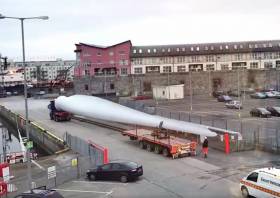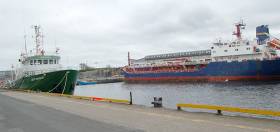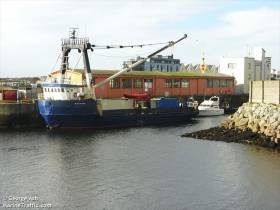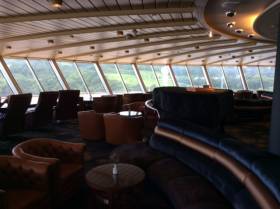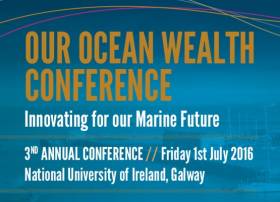Displaying items by tag: Galway Harbour
Time Lapse Video Of Giant Wind Turbine Blade At Galway Harbour
#GalwayPort - The Port of Galway has tweeted a time lapse video of an enormous turbine blade being manoeuvred into position for transport to the new Galway Wind Park project last week.
Galway Harbour is playing a key role in the two phases of the wind energy project, receiving the turbine tops, hubs and blades before they’re moved by road to the wind farm cluster between Galway city and Connemara.
SSE Ireland has much more on the Galway Wind Park project HERE.
Getting into position for the midnight run with wind turbine blades @Siemens_Energy @IMDOIreland @CTribune @AfloatMagazine @IWEA pic.twitter.com/gfMomVz8xk
— Port of Galway (@portofgalway) January 4, 2017
Was Galway Port Sabotaged? (Podcast)
In my last Podcast, I expressed the opinion that it is strange how things happen. This was again underlined for me as I prepared the new edition of my maritime programme which you can listen to below.
Galway Port Company has an ambitious €120m. plan for the future. It is going through the planning process at present, which has delayed it with various checks and examinations of what is proposed.
But the port company is determined to push the process forward and to achieve its goal in creating a modern port with the best of facilities on the Western coastline.
Galway is ideally placed to be a TransAtlantic port, so it has been said many times, but why has this not happened?
Is it possible that, as the business and economic leaders of the city tried to establish a TransAtlantic shipping line, their efforts were deliberately sabotaged by non-Irish ports which did not want Galway to command this trade?
Was the first ship chartered to run such a service, which had been given permission to carry what was then a valuable mail service in financial terms for the shipping service, deliberately sabotaged?
How could it strike the only rock in Galway Bay as it sailed in for the start of the service, leading to huge controversy and damaging the western port’s future?
The story, still an unsolved mystery, is told on THIS ISLAND NATION by author, journalist and Galwayman, Ray Burke. It is a fascinating story, well worth listening to and reading about. He links it into Ulysses, Nora Barnacle and James Joyce in his book ‘Joyce County – Galway and James Joyce’.
Click below to hear the story of how the voyage of the Indian Empire, intended to start Galway’s first TransAtlantic service, suffered a bad start in Galway Bay.
Aran Islands Snapshot: Galway Port Based Freight Operator Serves Islanders Essential Daily Needs
#AranIslands – As talks today to resolve the ongoing Aran Islands ferries dispute over passenger levies with Galway County Council, Afloat.ie takes a snapshot of a separate but freight-only operator providing vital supplies to islanders, writes Jehan Ashmore.
The affected Island Ferries Teoranta passenger ferry service: Rossaveel-Kilronan on Inis Mór, the largest of the Oileán Árann / Aran Islands was due to end last week, however, as Afloat previously covered the service is still operating as “a gesture of goodwill to the Islanders”.The ferry service will remain in place until 17 January 2017 however this date remains under review subject to how the discussions progress on the council-imposed passenger levy for the non-PSO ferry route to Inis Mór. In recent years this route has been subject to a sharp rise in fares.
As for the freight-only operator, Lasta Mara Teoranta, the company since 2005 has the Government contract to carry cargo not just serving Inishmor but also Inis Meain and Inis Oirr. These services are an essential lifeline for islanders. Lasta Mara is the main cargo company serving the Aran Islands by operating from the mainland based in Galway Port using MV Bláth na Mara (1983/330grt).
All the daily needs of the islanders are carried in containers on board Bláth na Mara from food stuffs (chill and frozen), to household goods, furniture and fuel. As for larger items such as vehicles and old fashioned form of transport that includes horses (given the tourist jaunting carts) and other lifestock are also conveyed on the coastal freighter.
A ‘roll-on roll-off’ i.e. ro-ro service from Rossaveel, Connemara is also provided by Lasta Mara using the MV Chateau-Thierry (see report photo) a former US Army tank landing craft. As previously reported the vessel brought emergency electrical generators due to power-cuts earlier this year.
Otherwise Chateau-Thierry's routine heavy goods cargoes are in the form of trucks, diggers and heavy plant and machinery. Such construction related vehicles were transported by Chateau Thierry from the mainland to Kilronan Harbour during the building of the new harbour. These vehicles rolled off the bow loading ramp onto the sandy beach at Kilronan, the capital of the Aran Islands.
The costs to pay for Kilronan's new outer harbour (see engineering award) are derived through the passenger levies which are at centre stage of the ferry dispute.
As for the cargo service in order to maintain all perishable cargoes remain frozen before departing Galway Port, the outer pier is where a warehouse is equipped adjacent to where Bláth na Mara berths. The Galway-Aran Islands routes should also be noted as Ireland’s longest distance domestic (island serving) commercial cargo service.
It is on such trading routes that the old traditional joint passenger /cargo service had run up to 1988. This was carried out by the State owned Coras Iompair Eireann (CIE) group’s vessel Naomh Éanna.
The veteran vessel built by Dublin Liffey Drydock Company in 1958 ran on the route for four decades. Since the service closed Naomh Eanna has remained languishing in the capital’s Grand Canal Dock Basin. In recent years she was transferred to a disused graving dock having been saved from scrapping. Against this backdrop there have been plans to restore the historic Irish built ship.
Holland America Line Makes Homage Atlantic Anchorage
#GalwayAnchorage – Holland America Line’s Prinsendam continues her 28 Day Celtic & Bourgundian Explorer Cruise with an anchorage call on Galway Bay today, writes Jehan Ashmore.
Prior to the cruiseship's arrival off Galway Port, Prinsendam so far has visited Dublin, Belfast (as reported), the Scottish western isles and Killybegs yesterday.
She has a capacity for 766 passengers and 460 crew and in which cruisegoers are been tendered ashore to the City of the Tribes. The US company founded in 1928 has a history of trans-Atlantic 'liner' calls taking anchorage in Galway Bay.
During the careers of their Maasdam and Ryndam this required the use of a dedicated liner tender, Calshot which HAL purchased in 1964 through a subsidiary, Port & Liner Services (Ireland) Ltd.
Prinsendam is the final caller out of six cruiseships this season, however Galway Harbour Company have scheduled in for 9 calls in 2017. Again this will include HAL's Prinsendam, at 38,848 gross tonnage which is deemed small these days. Much larger cruiseships are planned as the port have proposed an outer deeper water port which would not require anchoring off Mutton Island.
In the meantime, at the entrance to Galway on the outer pier is where a fleet of the cruiseships tenders are ferrying visitors back and forth. On the adjacent berth is LastMara Teo’s freight-only Aran Islands serving vessel, Bláth na Mara, whose fleetmate Chateau-Thierry transported generators from Rossaveal during power cuts on two of the three islands.
Also berthed but alongside the quays of the Claddagh area is the former Commissioners of Irish Lights Dun Laoghaire Harbour based buoy-towage tender Puffin.
The Bristol built tug retains its original name having been acquired in 2011. Afloat two years later made a trip on board Puffin, which also carries out ship mooring lines-boat duties along the Shannon Estuary. On that occasion, this involved a repositioning passage from the Rusal Aughinish Alumina plant jetty to the Port of Foynes.
Our Ocean Wealth Conference 2016 - Registration Now Open
#OurOceanWealth - Registration is now open for the 2016 Our Ocean Wealth Conference at NUI Galway on Friday 1 July.
As previously reported on Afloat.ie, this year's conference will again take place alongside SeaFest, Ireland's national maritime festival, hosted this year in Galway Harbour from 2-3 July.
The full conference agenda is yet to be announced but items of focus will include:
- Progress on the implementation of Harnessing Our Ocean Wealth - Ireland's Integrated Marine Plan
- Into the Blue: Economy and Growth
- Map, Observe, Predict: Innovating Across the Atlantic
- Our New Relationship With the Sea
For more information or to register for the conference visit www.ouroceanwealth.ie.
Harnessing Our Ocean Wealth Conference 2016 - Save The Date
#OurOceanWealth - NUI Galway will host the third annual Our Ocean Wealth Conference on Friday 1 July.
The previous two conferences – in the inaugural event in Dublin Castle and last summer's in Cork Harbour – have outlined the progress in implementing the Government's 2012 Harnessing Our Ocean Wealth: An Integrated Marine Plan for Ireland.
And like last year's event in Ringaskiddy and Haulbowline, this year's conference will precede the return of SeaFest, Ireland's national maritime festival, in Galway Harbour from 2-3 July.
Further details are available at the Our Ocean Wealth website HERE.
Another upcoming date for the diary is the 26th Irish Environmental Research Colloquium.
'Ecosystem Services for a Sustainable Future' is the title of Environ 2016 at the University of Limerick from Tuesday 22 to Thursday 24 March.
For more information contact Sinead Macken at 086 807 1498 or [email protected] or visit www.environ2016.org
Yuletide Yacht Brings Christmas Glow To Galway Harbour
There's an impressive glow from the Christmas lights hoisted high on the 90–foot mast of Atlantic Blue, a Hanse 531 yacht, moored in Galway Harbour this Christmas.
The maritime yuletide decorations have lit up the west coast harbour that is making an ambitious bid for a Tall Ships Visit in 2019.
Galway Prepping Bid For Tall Ships Races In 2019
#TallShips - Galway could join the running to host the Tall Ships Races in 2019, as the Connacht Tribune reports.
City councillor and former Galway mayor Padraig Conneely is spearheading efforts to attract the tall ships to Galway Harbour – and the potential €50 million boost to the economy they'd bring with them.
Preliminary discussions have already taken place to explore the viability of a bid for the annual sailing spectacle in light of Dublin's opting out of the running for 2019.
“Galway has a great track record in hosting maritime events and the city has proven itself to be a great host for such events," said Cllr Conneely, citing the Volvo Ocean Race finale in 2012 and the stopover in 2009.
The Connacht Tribune has more on the story HERE.
Galway Hosts In-Port Races As Powerboating's Venture Cup Returns in 2016
#Powerboats - The Venture Cup for powerboat racers headlines a "bumper calendar of events" in Galway Harbour next June, as the Connacht Tribune reports.
Galway will be the only in-port race stop on the 1,000 mile challenge, reportedly "the longest, toughest and most prestigious powerboat race in the world".
And what in-port racing that will be, as up to 25 of the world's very best powerboat racers will blitz past Salthill Promenade towards the Atlantic from 16 June at such speeds that they'll be using the Aran Islands "as a chicane".
Not only that, but the celebrity involvement is sure to bring out the crowds to Galway and ports clockwise around Ireland from Cork to Dublin.
TV adventurer Bear Grylls is believed to have booked a berth on board one of the super-speed boats that can go as fast as 240mph, while Ireland will be represented by the youngest competitor, 18-year-old Adam Brennan – son of hotelier and host of RTÉ TV's At Your Service, John Brennan.
The Connacht Tribune has more on the story HERE.
Galway Port Expansion To Go Ahead Under Habitats Directive
#GalwayPort - Business leaders have welcomed the news that the €126 million Galway Port extension project will be proceed under the IROPI section of the EU Habitats Directive.
According to the Galway Independent, the decision by An Bord Pleanála to proceed under IROPI – or Imperative Reasons of Overriding Public Interest – is a first for Ireland.
Progress will involve establishing replacement habitats for those that would be adversely affected by the port extension. As previously reported on Afloat.ie, it was determined that a number of reef, mud and sand habitats would be destroyed by the 24 hectares of land reclamation required.
But there's better news for those with environmental concerns, as planners have determined that two nearby Natura sites – the Inner Galway Bay Special Protection Are and the Lough Corrib Special Area of Conservation – will see no impact, while priority habitats at Lough Atalia and Renmore Loughs will not be "negatively affected".
The board has also recommended "tight co-operation" between the Galway Harbour Company and local authorities to ensure conservation is made top priority throughout the project.
The Galway Independent has more on the story HERE.


























